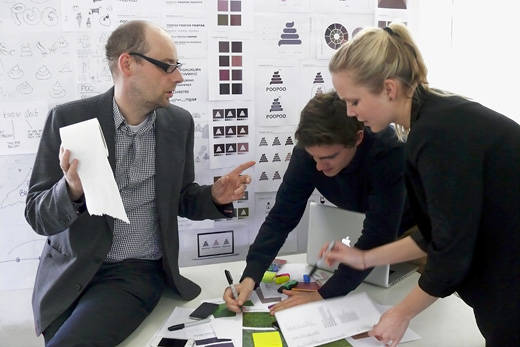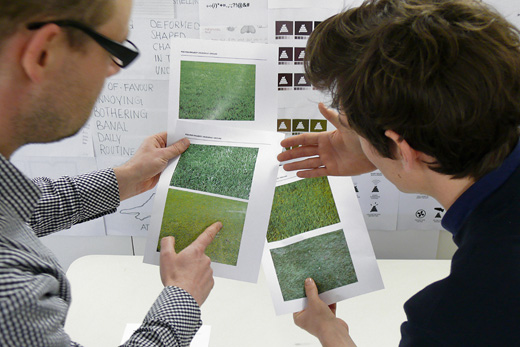Creative Strategy
- Started
- Last post
- 19 Responses
- grafisk
Im currently defining our creative strategy. I work in the UX team, so far ive defined the principles of;
Holistic (joined-up marketing/product, x-channel strategy)
Adaptive (responsive design, localizable)
Innovative (novel, new, contemporary, pushing boundaries)
Honest (create products of integrity)
Beautiful (attention to detail, polished output, domain experts)Anyone lese written such a document or have examples to such a thing online?
Any input very much welcome...
- monospaced0
Oh the pretty words! And while they are good, creative words, and all important parts of a creative strategy, they don't speak much to the implementation at all.
- yupzenmasterfoo
- "localizable"monospaced
- As i said ie just started writing this, so i will get to the detail
grafisk - aye23kon
- zenmasterfoo0
^that.
Using words like honest, innovative and beautiful - while illustrative - are empty and tend to confuse or complicate you message rather than conjure a cohesive, and direct strategy for your department/business.
- rodzilla0
why how what
- UKV0
you're going to get a bunch of answers, but from the agency point of view, should probably look at integration as food for thought.
In a nutshell; start with your customer, map their lives and culture, and look for insights about them. Reverse engineer the insights back to the brand, and then execute 360º around the customer. A great insight will lead to a thousand big ideas. The very last thing to be thinking about is the tactical side, where most people seem to start (and wind up with predetermined outcomes).
- mind 'splodes with marketing speech overloadmonospaced
- hilariousmonospaced
- Thanks UKVgrafisk
- Tools o' the trade Monospace...UKV
- UKV0
Decent video expanding on "Why how what".
- vaxorcist0
UKV's got an interesting point....
Hardest part is getting executive sign-off....
Question: are you at a:
1. agency with clients
2. business-to-business with clients
3. business-to-consumer with customers
- grafisk0
For my part i work for;
business-to-consumer with customers
- vaxorcist0
ok.... all this reminds me of the difference between the thinking at a design agency, vs an ad agency....
Design agencies and design schools use language like you used above...
Ad agencies use a different set of words, often related to:
The Central Insight into the customer's reptile-like mind's inner buying trigger...
for example, at a very smart ad agency, we were going over focus group footage of a bunch of young male car stereo buyers... one guy said something we could never put in a client proposal, but it was the central insight into that demographic...
...he said "A thumping bass is like tits in your face!"
So.... we learned that our ads had to indicate an outragousness and a sense of transcendent oh-my-god-holy-shit ness
not just a bunch of design buzzwords or ideas, but a visceral amazingness, done with some amount of good taste, of course...
- qTime0
"Im currently trying to justify my stupid existence. I work in the UX team, so far ive defined the principles of;
Holistic (joining up the universe in a creative manner)
Adaptive (Something that people on the interned keep mentioning, I'll put it in to sound like I'm up to date on things)
Innovative (A bit like pushing the envelope or expanding my brown ring)
Honest (to be honest, this just put in so the client thinks I'm not making bull shit up)
Beautiful (I bit like my boss's wife 10 years ago)Anyone lese written such a document I can copy because I can't think for my self?
Any input very much welcome...
- d_rek0
Develop a deeper understanding of your audience and figure out how they would communicate your ideas among themselves. Vaxorcist hit the nail on the head with the "tit's in my face remark".
Would your client/customer sit around going, "This is such a holistically adaptive example of innovative, honest and beautiful UX design!"
Probably not. It might be more along the lines of "That app I just used is stupid simple. I love it."
Language is a powerful tool.
- This is exactly how I'm approaching it, we are a user driven teamgrafisk
- vaxorcist0
OK.. here's a shortened version of what I remember the process was from one very smart ad agency I worked at some time ago....
Initial Questions:
1. Major or Minor change in direction?
(we learned not to say "evolutionary or revolutionary" when we learned one client was very religious... )2. Business Objective in 10 words or less
(increase brand awareness among younger demographic by 20%,etc.. how do you measure success or failure?)3a. Stakeholders : Who exactly approves what?
(who can say final "yes", and who can say "only no"... do NOT show creative to "only no" people till that creative has already been approved by somebody else...)3b: Stakeholders: Who has to cooperate? Do we need to hookup with IT dept, do we need to get materials from somebody?
4. Target Market defined, and NO IT IS NOT EVERYONE....
5. START RESEARCH:
- Focus groups BEFORE any creative, NEVER AFTER....
(That way, you get your CENTRAL INSIGHTS from your focus groups, but you don't get the FUCKING PEANUT GALLERY critiquing your work..remember that likeability of an ad has NOTHING to do with its likleyhood to make you buy something)-Competetive Review (Sometimes... depends on product/market)
-Sometimes competing products feedback from focus group, sometimes a market position research...-Account Planning People determine what they think is the CENTRAL INSIGHT into consumer's mindset.
-------------THEN...
CREATIVE AGREEMENT written based on all of the above,
client asked to approve or argue AT THIS TIME, not during the creative, it is VERY IMPORTANT to have the client buy-in to the creative agreement, that way arguments are about the principles involved, not about the colors or fonts or whatever....
-------------THEN...
Creative roughcuts/storeboards/sketches/e... done based on all of the above, and each decision is framed in response to the creative brief, even if it's just a DESIGNER WHIM, it's pitched to client as if it's DIRECTLY FOLLOWING the creative agreement he already approved.
Inside the agency, a CREATIVE BRIEF is written that's a slight variation of the creative agreement, more design-focussed, more tied to agency's vocabulary, possibly closer to what design shops use, but still highly based on the central insight...
------------THEN...
You pitch creative, but ONLY to somebody who can absolutely and finally approve it, never to some random people first, unless you need to build momentum inside your client's company, then you show little bits of cool stuff to those other people, but never the whole thing... keep the momentum and mystery going.. you're developing something really cool... don't show your cards too soon to the wrong people(!)...THEN..
You hope and pray everything is approved, without any random last minute shit, any make the logo bigger, or any shit from the IT department saying that everything has to wait for their SAP consultant to show up in 6 months... if any shit happens, you have your client's buy-in to your initial document, where you list STAKEHOLDERS and who is RESPONSIBLE FOR WHAT...
and of course, after a while, you compare the results to whatever your initial business objective was.. if you succeed, great! take credit, even if the economy just improved, or whatever... if you're below the hoped-for-result, submit to as many ad award shows as possible, you might win an award(!)....
good luck, this is ad/marketing agency-focussed, not design-agency focussed, but some parts may be useful....
- <I like how the poster is getting us to do his work. being dumb can have it's advantages...robotron3k
- No, having input from your piers though a design forum is useful, why do you think I'm dumb?
grafisk - Very insightful vaxorcist, I'm trying to have a doc that designers actually sue, but drives the business to realise its valuegrafisk
- maikel0
^
Hey grafisk, the only thing that remotely looks like strategy-related is what vaxorcist has pasted there. Interesting and helpful.All the other stuff is just what agencies call strategy which is a mash up of buzzwords and fancy crap that leaves plenty of room for ambiguity and gives no direction.
Strategies are in place to ensure you align your business so that your tactics (operational teams) know what to do.
Focus on things that make sense other than pretty words if you are after something useful - or keep the buzzwords to impress the 'we need something innovative' client.
- bjladams0
i like some of this - but a lot of it is a bit too jumpy.
http://www.funnelbox.com/who-we-…
- vaxorcist0
more semi-random ideas....
different defintions of strategy...
-client management strategy
-strategy to determine tactics in order to reach your objective
-strategy as whatever you can say to get client to say yes?!?yes, design agency vocab vs ad agency vocab...
I think much of the design-agency vocabulary tends towards tactics, not strategy... i.e. our tactic is to "use very thin elegant fonts" and our strategy is to "appeal to the elegance-fetish of high-end condo buyers with new money who want to look like old money..."
this does remind me of an oddball "strategy" seemingly used by a design agency I interacted with when I worked with a nonprofit agency that worked with highschool afterschool programs...
the design agency pitched things in terms of how they conformed to what seemed like universal principles of aesthetics, the platonic ideal forms, how this was, well, descended from the heavens, so the client better not question it(!) Completely different from my agency mindset, but It wasn't my job to stir things up in that meeting... needless to say, a year later, the graphics done by that agency were replaced by images from a contest done by the kids themselves.... I wasn't a fan of either approach...
So, as a "client management" strategy, the "appealing to the eternal rules of design" isn't always great...
- vaxorcist0
... and for minor changes, you might read:
http://www.wired.com/business/20…
The A/B Test: Inside the Technology That’s Changing the Rules of Businessmy takeaway quote:
Google insiders, and A/B enthusiasts more generally, have a derisive term to describe a decisionmaking system that fails to put data at its heart: HiPPO—”highest-paid person’s opinion.” As Google analytics expert Avinash Kaushik declares, “Most websites suck because HiPPOs create them.”


